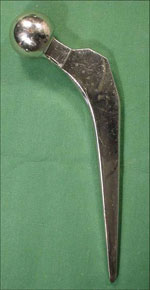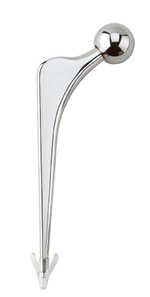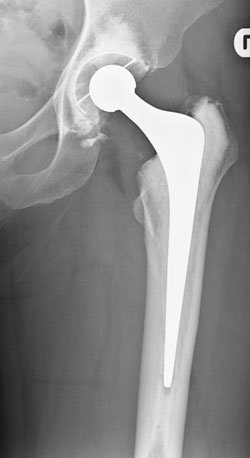The Exeter Hip System celebrates 40 years and 1 million stems
The year 2010 will see two major milestones for the Exeter Hip Replacement (Stryker): The 27th of November will be the 40th anniversary of the first Exeter hip stem implant in a patient; and the millionth patient, somewhere in the world, will receive an Exeter stem.
The Exeter stem was conceived through collaboration between Robin S.M. Ling, OBE, MA BM (Oxon), Hon DSc, FRCS, Hon FRCSEd, an orthopaedic surgeon at the Princess Elizabeth Orthopaedic Hospital in Exeter, U.K., and Clive Lee, PhD, a young engineer at the University of Exeter. The collarless polished tapered cemented hip stem that they designed was unlike any other at that time.
Although Ling and Lee are the first to insist that serendipity played a significant part in the original design, we now understand that the remarkable long-term success of this stem is due to this polished tapered design with its ability to behave like a wedge or self-locking taper. Because it is polished and collarless, it is free to subside at the stem-cement interface. The wedged, tapered shape, which is wider proximally than distally, allows for self-locking and the preferential transmission of loads to the proximal femur (the taper slip principle).
Its design was totally contrary to the existing philosophy for cemented stem fixation at the time — namely to try to bond the stem as solidly as possible to the bone cement, often by using a collar and texturing or pre-coating the stem. The Exeter, conversely, is polished and deliberately not bonded. Rather, it is free to micro-subside at the stem-cement interface and thus act as a self-locking taper, effectively and continually tightening step by step throughout the life of the hip. Long-term studies have shown that this process continues, micron by micron, to a total of 1 mm to 2 mm over 30 years.
Ling and Lee observed their patients closely and insisted that the stem only be used in Exeter under their direct supervision for the first 5 years. There were some early problems associated with the relatively weak steel that the stem was then made from; therefore, in 1975 the stem was made heavier in section and from stronger steel. At that time it was not appreciated how critical the polished surface was to the function of the stem, and so for cost and fashion reasons the surface was changed from a mirror finish to a matte surface, while retaining the collarless tapered shape.
|
|
|
|
The original 1970 Exeter stem (left) and the1988 Exeter Universal modular stem (right) both have a polished surface. Images: Exeter Hip Unit, Princess Elizabeth Orthopaedic Hospital |
|
Within years, stem loosening and osteolysis were seen around a number of these matte stems — something that was almost never seen in the earlier polished version despite many more years of use. It was realized that this relatively smooth matte surface was enough to hold the stem up and stop the taper slip process, preventing self-locking with the associated secure and benign long-term fixation. In 1986, the Exeter stem reverted back to the original polished surface; in 1988, the stem was made modular (Exeter Universal) to accommodate femoral heads of different lengths, sizes and bearing materials.
Worldwide use, success
The use of the Exeter hip system has grown steadily since that time. There are currently 21 primary and 7 revision stems in the Exeter line. Not only has the Exeter group reported excellent long-term results from their own center, these have been reproduced in other units around the globe. These results, the long-term preservation of bone stock associated with taper slip loading and the ease of restoration of anatomy due to the flexibility of the system have resulted in the Exeter stem being one of the most commonly used hip stems in the world. As a result of this popularity, this year will see the millionth patient receive an Exeter stem.
The collaboration between Ling and Lee resulted in more than just the design of a hip stem. As well as observing their patients closely from the outset and setting up a comprehensive outcomes database, Ling and Lee also extensively studied the behavior of bone cement and the techniques of hip arthroplasty surgery. Together with their colleagues and successors in the Exeter group, this has resulted in a number of advances and innovations in the use and understanding of these systems in both primary and revision hip arthroplasty.
|
|
These innovations include, in particular, techniques and instrumentation to improve both femoral and acetabular cementing, developments in surgical technique, education and training and revision hip surgery. Graham A. Gie, MBChB, FRCS, FRCSEd(Orth), from Exeter, working with Ling and in collaboration with the Nijmegen group, was the first to undertake the revision technique of femoral impaction bone grafting; the Exeter group has also popularized the technique of cement-in-cement femoral revision, demonstrating reliable long-term fixation with this simple technique.
Specialist training
Education and training have always been key issues for the Exeter group, and Ling and Lee started the initial Exeter Hip Symposia in the 1980s. This program has grown steadily over the years. The Exeter Hip Unit now hosts three full-time specialist training fellowships in hip surgery which have been undertaken by surgeons from around the globe, with additional visiting fellowship posts specifically for Scandinavian and Asia Pacific surgeons. In collaboration with and supported by Stryker, courses in primary hip arthroplasty, complex and advanced primary surgery and revision arthroplasty are now run every year in Exeter and many other centers.
The enormous contribution over the last 40 years to hip arthroplasty surgery by the Exeter group was recently recognized by the award of a special commendation by the British Orthopaedic Association. A 369-page book, The Exeter Hip: 40 Years of Innovation in Total Hip Arthroplasty, has also just been released to coincide with the 40th year anniversary. With 49 international co-authors, the book covers all of the principles and practice of hip arthroplasty with particular emphasis on the Exeter system.
Reference:
- Ling RSM, Lee AJC, Gie GA, et al, eds. The Exeter Hip: 40 Years of Innovation in Total Hip Arthroplasty. Exeter, UK: Exeter Hip Publishing; 2010.
- Matthew Hubble, MBBS, FRCS(Tr&Orth), is from the Princess Elizabeth Orthopaedic Centre, Exeter, UK. He can be reached at matthewhubble@aol.com. Hubble is a member of the Exeter Hip development group which receives funding from Stryker. Stryker also supports research staff and the hip fellowship at the Princess Elizabeth Orthopaedic Centre, Exeter, U.K.



